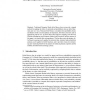Free Online Productivity Tools
i2Speak
i2Symbol
i2OCR
iTex2Img
iWeb2Print
iWeb2Shot
i2Type
iPdf2Split
iPdf2Merge
i2Bopomofo
i2Arabic
i2Style
i2Image
i2PDF
iLatex2Rtf
Sci2ools
ECSQARU
2007
Springer
2007
Springer
Interpreting Belief Functions as Dirichlet Distributions
Traditional Dempster Shafer belief theory does not provide a simple method for judging the effect of statistical and probabilistic data on belief functions and vice versa. This puts belief theory in isolation from probability theory and hinders fertile cross-disciplinary developments, both from a theoretic and an application point of view. It can be shown that a bijective mapping exists between Dirichlet distributions and Dempster-Shafer belief functions, and the purpose of this paper is to describe this correspondence. This has three main advantages; belief based reasoning can be applied to statistical data, statistical and probabilistic analysis can be applied to belief functions, and it provides a basis for interpreting and visualizing beliefs for the purpose of enhancing human cognition and the usability of belief based reasoning systems.
| Added | 07 Jun 2010 |
| Updated | 07 Jun 2010 |
| Type | Conference |
| Year | 2007 |
| Where | ECSQARU |
| Authors | Audun Jøsang, Zied Elouedi |
Comments (0)

